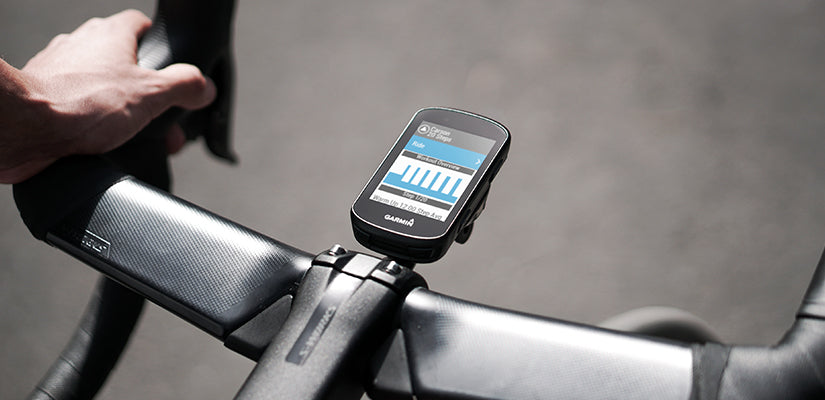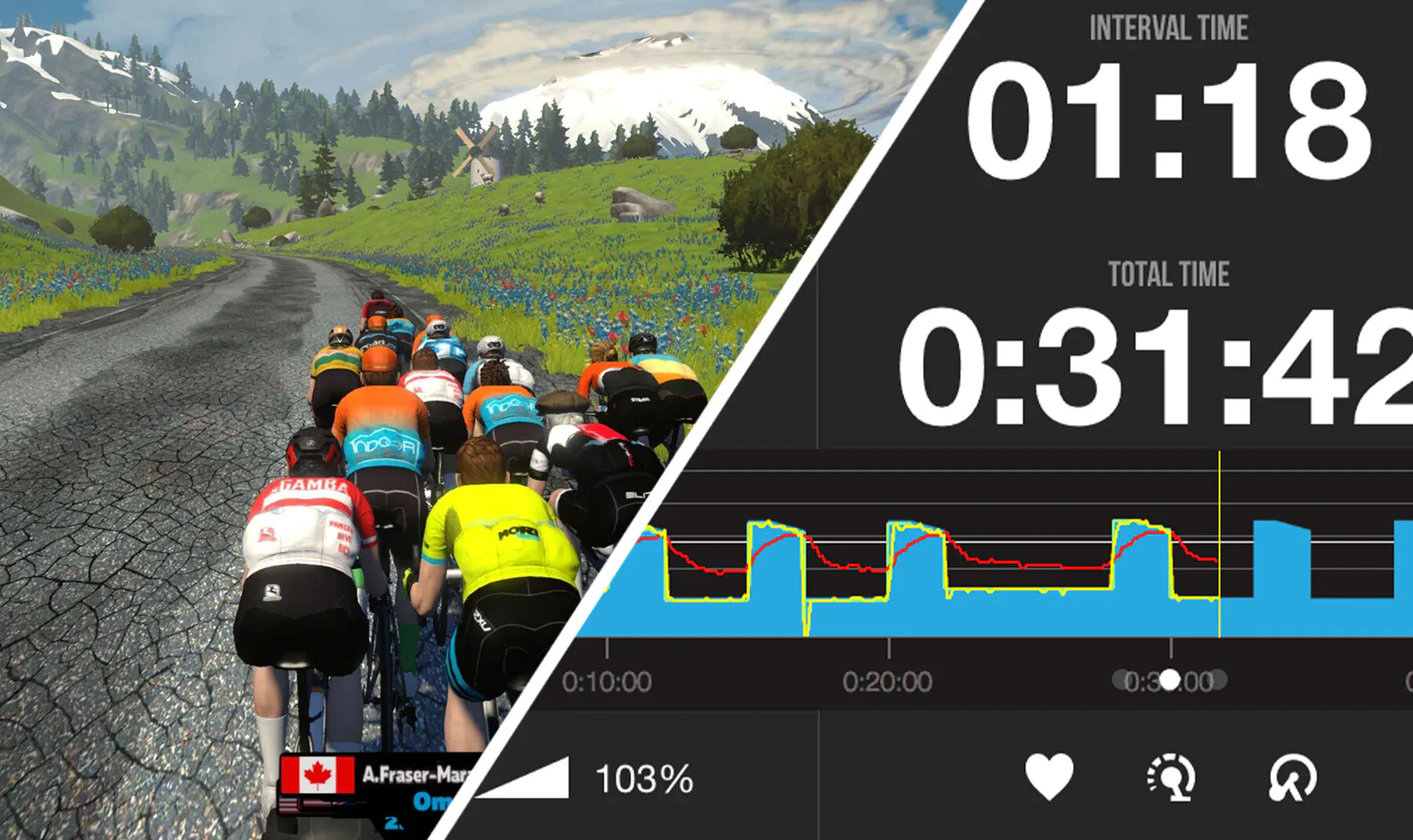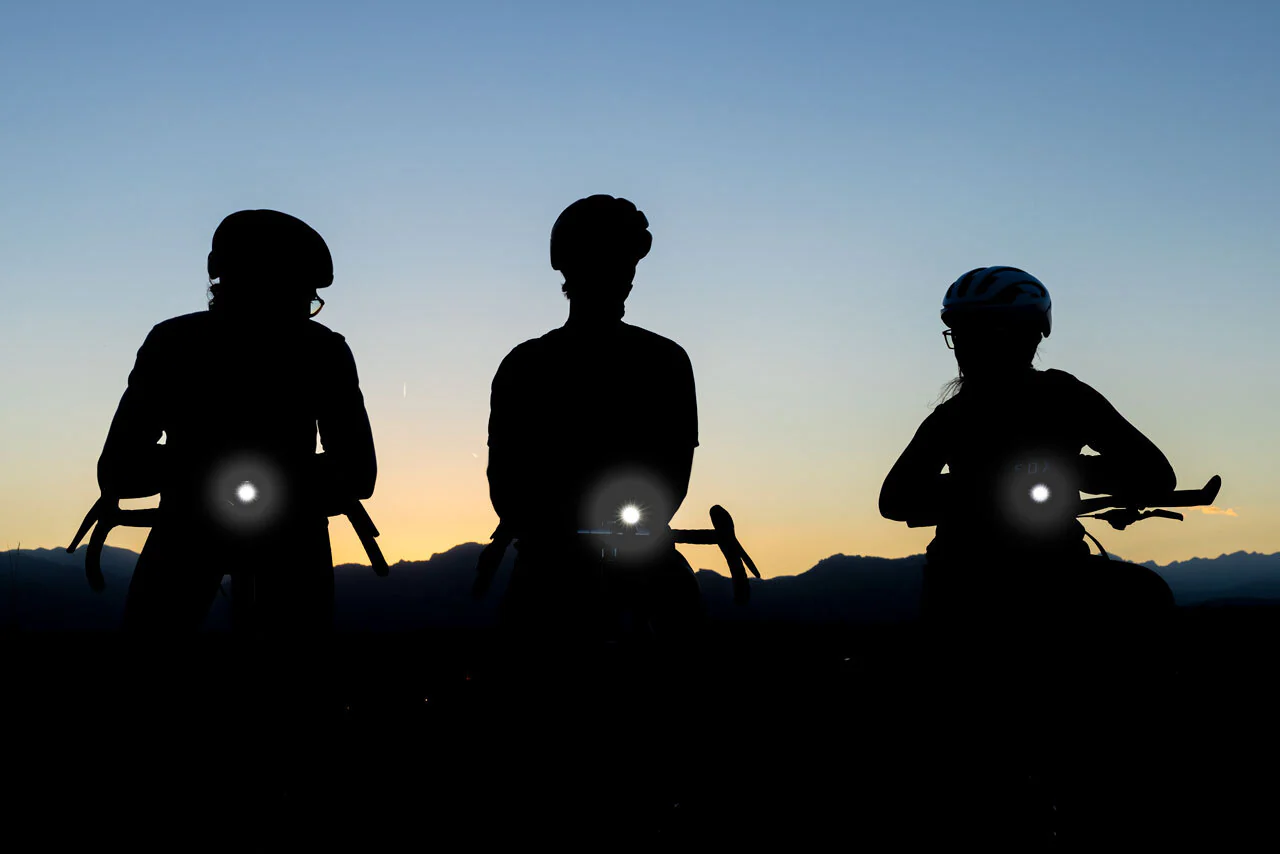Every morning I see people riding to work. Rain, snow, hail, fire, it didn’t matter. there was also someone zooming by on the shoulder while I sat in traffic. It was inspiring. These people are out there on their bikes, getting fit, showing up to work with a smile — and I wasn’t.
So last summer, I decided to start commuting by bike. I live about 19 miles from work. Regularly riding this commute seemed crazy at first. But with encouragement and advice from some co-workers (many who commute by bike daily and live even farther away!), I was able to find my groove and make it a part of my routine.
I made the commitment to commute by bike for an entire year and it’s one of the best things I’ve ever done for myself. If you’re interested in commuting, training during your commute, or just committing to ride your bike more often, here are some tips for making your time on the bike more enjoyable.
[button]SHOP BIKES[/button]
 At first, I felt tired. REALLY tired. Then I got less tired. Then I felt normal. Now I feel superhuman. The power of daily bike commuting.
At first, I felt tired. REALLY tired. Then I got less tired. Then I felt normal. Now I feel superhuman. The power of daily bike commuting.
First, a little background. I fell off the wagon in recent years and severely neglected my bikes and my fitness. This was due to many new factors in my life, like a lovely (but needy) baby at home, oh, and a global pandemic. At my last health screening, I was overweight and the doctor warned me about my cholesterol. That shock, paired with the guilt I felt when driving a gas-guzzler to work made me realize that I had to make a change.
Not everyone has the luxury of being able to ride daily. Commuting by bike as much as possible, even if only once a week, is the next best thing. Fortunately, my employer encourages bike riding and other eco-friendly transportation methods. This has helped me lose weight, become happier, and it reignited my passion for riding. I’ve learned a lot in the process.
1. Ease in
When I started commuting last year, I essentially came off the couch. My first outing on the bike was slow and discouraging. Afterward, I was starving and unfocused at work. It felt like my body took two days to recover. When you’re motivated to try something new and exciting, it’s easy to jump in headfirst, get discouraged, and lose that motivation before a solid routine can develop.
The more you intend to ride, the more you need to manage your fatigue and recovery time. When one of my fitter co-workers found me lying on a couch in the corner, he suggested I start with less volume than I had originally planned and work my way up. This is key for any rider looking to improve their endurance and up their mileage whether they commute or not. Manage your fatigue so you can keep putting in the work, improving gradually, and developing good habits.
I started at around half the volume I was hoping to achieve later in the year, essentially riding every other day. I would drive in one morning with my bike, ride home in the evening, ride back the next morning, then drive home. This gave me more time to recover as my fitness improved. As I got used to the effort, I was able to add more days of riding into the mix. Before I knew it, I had done a full week of riding without a hint of soreness or fatigue. It became normal. No matter what level rider you are, slowly building up toward your goal is the key to success.
2. Find motivation, but maintain discipline
When my will to ride begins to wane, I always have to remind myself about the difference between motivation and discipline. Motivation inspires you to ride your bike, but discipline is what keeps you on your bike. Motivation can come and go, and it will grow stronger or weaker day to day. If stress, fatigue, obligations, and distractions begin to decrease your motivation, good discipline will keep you on track.
A few weeks into my commuting campaign, I woke up lazy and tired. The temptation to just get in my car and drive to work was almost overwhelming. Though I was unmotivated to ride, I already had a plan to fight through. I laid out my riding clothes the night before so they were ready to go (this is a super effective tip). I had given my wife the car keys so they would be harder for me to grab in the morning. I set a series of increasingly annoying alarms that would ensure I woke up with enough time to ride. And, most importantly, the night before I emphatically declared to myself several times that I WILL DEFINITELY ride or suffer severe karmic consequences.
 Getting out the door is always the hardest part. Once I finally get on my bike and start riding, I snap back into the groove and I am always super happy to be on my bike again. Eventually, mornings get easier, until they became a normal routine. I feel like I've hit the point where I'm disciplined enough to wake up not wanting to ride and still go through the motions needed to get on my bike without thinking. That's super satisfying. I can still fail occasionally. But I look at those moments as opportunities to seek improvement. I don’t let them create a downward spiral.
Getting out the door is always the hardest part. Once I finally get on my bike and start riding, I snap back into the groove and I am always super happy to be on my bike again. Eventually, mornings get easier, until they became a normal routine. I feel like I've hit the point where I'm disciplined enough to wake up not wanting to ride and still go through the motions needed to get on my bike without thinking. That's super satisfying. I can still fail occasionally. But I look at those moments as opportunities to seek improvement. I don’t let them create a downward spiral.
This is closely connected to the first point of easing in. Discipline is easy to break, and if you go too hard too soon, it simply won't hold up. So in the beginning, I set short-term goals, like riding Monday, Wednesday, and Friday. This fed long-term goals like riding Monday, Wednesday, and Friday for the whole month. When I succeeded, it felt good. It rejuvenated my motivation which further developed my discipline. All of these things can build and improve. Discipline can be learned and trained, and the more disciplined you become, the better you’ll be as a commuter and a rider.
3. Find little bits of adventure
Having the discipline to carry on riding can feel meaningless if you’re struggling to enjoy the ride itself. Commuting every day can turn into a mindless slog, so I do what I can make it as fun as possible. One key to maintaining my interest and keeping a week of commuting fun is mixing up the route I take home.
It doesn’t take much. Often just some small deviations in the route can provide enough to keep my daily ride from getting stale. For my personal commute, I have explored a spiderweb of connecting roads that can all ultimately lead me back to my house. Often these aren’t the fastest or most efficient options, but they're fun and sustainable. 
Getting lost can be good.
Whenever I have time or the opportunity, I will try a road or combo of roads that I have never ridden. I’ll switch up between riding paved, dirt, and gravel roads, and even venture onto occasional bits of singletrack with my gravel bike. I’ve stopped at random taco trucks, gas stations, and parks that I normally would never visit.
 It’s not much, but these small detours on my daily commute help keep things fresh and my mind active. If (or rather, when) I get lost, I have GPS to save me. Speaking of GPS, tracking everything on Strava has been a key component of upping both my motivation and fun. Seeing the miles tick up feels good. And it gamifies my commute a bit. I amuse myself by trying to set PRs or get the "Local Legend" award on various segments.
It’s not much, but these small detours on my daily commute help keep things fresh and my mind active. If (or rather, when) I get lost, I have GPS to save me. Speaking of GPS, tracking everything on Strava has been a key component of upping both my motivation and fun. Seeing the miles tick up feels good. And it gamifies my commute a bit. I amuse myself by trying to set PRs or get the "Local Legend" award on various segments.
[button]SHOP BIKE COMPUTERS[/button]
4. Dress for the ride

For bags, I prefer large, waterproof, roll-top backpacks. These bags are easily expandable and have a large single compartment which provides a huge amount of space for clothing, food, work supplies, and other gear. My strategy has been to stuff my bag full of the work clothes I’ll need for the week and haul them all in on Monday. This allows me to carry less later in the week so I can focus more on the ride itself. If you have a bike that can fit racks and panniers, or other bike bags, then use them! I wish my bike had them so I wouldn't have to load up my backpack so much.
[button]SHOP BIKE BAGS[/button]
You can ride in any clothes that are comfortable. Ride in your work attire if you’re commute is easy and short enough. But when I’m going to be in the saddle for longer than 20 minutes, I prefer to wear proper cycling shorts or bibs with a comfortable chamois. More than any other piece of riding gear, cycling shorts or bibs improve the riding experience by increasing comfort and dryness, allowing you to ride further, longer, and more often.
Plenty of riders are picky about the shorts or bibs they wear. But for commuting, I prefer entry-level bibs since my regular riding wears them out faster. I can buy multiple pairs for less, but I still have a couple of high-end bibs I save for longer, more serious rides and workouts.

In colder months, I check the weather daily to decide what I need to stay warm. If the weather is looking suspect, I always carry extra clothing. Excess layers can always be removed and stored. Most of my spring and fall kit consists of basic thermal gear like arm- and leg-warmers, vests, toe covers, and headgear which are all lightweight and packable.
Look for cold-weather gear that is windproof, breathable, and moisture-wicking, as it prevents heat loss from your sweat. Most cycling specific winter gear combines these qualities to effectively keep you dry and warm when you’re riding hard in cold weather. If you're really committed to cold-weather riding, consider winter cycling shoes. They are much more than effective than shoe covers at keeping your feet dry and warm.
Bad weather is something that will derail a lot of riders. Plenty of times this last winter I watched rain, sleet, or snow dump from the sky and I questioned my own intelligence. When I was fit and training a lot, I was a total fair-weather rider. But when I started commuting every day, I had to harden up and learn to love going out in harsh weather.
I've found that as long as I’m properly dressed, riding through nasty conditions can actually be fun. There are always dire moments, but I find the memories I create are often some of my strongest and most cherished. Going out in a blizzard or a thunderstorm becomes a small adventure, something that has sadly become rare in my adult life. After fighting through horrendous weather, I will often show up to work and come home with a buzz I'd never get from driving.
Here are examples of the riding clothes I prefer for each season. As the weather gets colder or wetter I will mix and match as necessary to remain comfortable.

| Summer | Spring / Fall | Winter |
|
|
|
[button]SHOP CYCLING APPAREL[/button]
5. Keep things clean
If you’re riding regularly, it’s important to always ride in a clean kit. My home life is hectic, laundry gets forgotten, and I’ve been tempted many times to reuse a previously worn pair of bibs. Yes, it’s gross, and I’m not proud of it. I’ve gotten away with it sometimes. But many more times I developed some form of irritation that made riding harder and miserable.
I’ve found owning six pairs of bibs to be a good amount. There’s a pair for every day I ride and then one extra pair to get me by when I inevitably get behind on laundry. Your mileage may vary. If you’re diligent about washing, you could get away with only one or two pairs.
When it comes to your body, try to keep the saddle region clean and dry after riding. This is your best defense against irritation and saddle sores. Fortunately, our office has a shower to wash off after a ride. If you don’t have access to a shower, baby wipes are your best friend. I keep a pack at my desk for when I don’t have time to squeeze in a shower and will wipe off when I change.

When it comes to your bike, just be sure to clean and lubricate the drivetrain regularly to ensure it continues operating problem-free. This is especially important in winter and in wetter climates since road grime will degrade shifting performance and accelerate wear.
[button]SHOP BIKE TOOLS & MAINTENANCE[/button]
6. Choose the right bike & gear
The right bike is any bike that you can ride comfortably and consistently. It can be your road racing bike, a mountain bike, or a hybrid commuter bike. Ideally, the bike you choose should suit your local roads. I ride a versatile cyclocross/gravel bike because my town has tons of options for paved and dirt roads, gravel paths, steep climbs, flat terrain, and singletrack.
I’m riding a Cannondale SuperX SE cyclocross/gravel bike. It is simple and cheap to maintain. My tires aren’t the lightest or fastest, but they are puncture-resistant for reliability and high-volume for increased comfort. As the seasons change, I will swap to even beefier gravel-specific tires to handle inclement weather and sloppy road condition.
[product-block handle="2019-cannondale-superx-se-force-1-m"/]
Fenders are a necessity when the roads are wet, to keep spray from soaking your clothing. If your bike doesn’t have dedicated fender mounts, many companies make lightweight, clip-on fenders that are fairly effective, like those shown on my Cannondale.
[product-block handle="portland-design-works-origami-clip-on-fender-reflective"/]
In the winter months, bring riding lights because it gets dark earlier and visibility becomes an issue. If you’re riding in complete darkness a light with at least 500 lumens is best. All lights aren’t created equal, but in general, the more lumens the better. The light can be bar-mounted, helmet-mounted, or both.
[product-block handle="niterider-swift-500-headlight-vmax-150-taillight"/]
[button]SHOP BIKE ACCESSORIES[/button]
7. Fit in Training on Your Commute
For time-crunched racers, commutes may be the only consistent time they have on the bike. Trying to fit a good workout into your schedule can be difficult. Riders who are targeting certain fitness or race goals have to shape their commutes to facilitate their training. When I got into Unbound Gravel last year, I used my commute home everyday to train for the 200-mile epic.
I choose routes to support the workout, and they were often be a very roundabout so I can do extended blocks or intervals. One of the keys to training during your commute is reducing the amount of time you’re interrupted by stops. That means avoiding stoplights, stop signs, cars, and other traffic as much as possible. I often took the long way home to ride roads outside of town.
 I used Trainerroad's outside workouts to structure my commutes. Photo courtesy of Trainerroad.
I used Trainerroad's outside workouts to structure my commutes. Photo courtesy of Trainerroad.
A lot of my commute training incorporated tempo, sweet spot, and suprathreshold intervals. The goal was to build the large aerobic engine needed for endurance racing. If I wasn't doing a specific workout, I'd be riding at recovery pace, which is very, very easy.
Even if you’re not doing structured training, simply riding your bike every day will make you fitter. I’ve found that the amount of volume I’ve accumulated from easy daily riding over multiple months has given me a great base that I can build on when I actually feel like pressing on the gas.
I'm going to keep riding through the winter this year and hopefully shed even more pounds. Hopefully, you can apply some of this advice to your own riding and get out on the road more.
[button]SHOP BIKES[/button]
Do you commute to work? What tricks and tips do you have? Let us know in the comments!

























